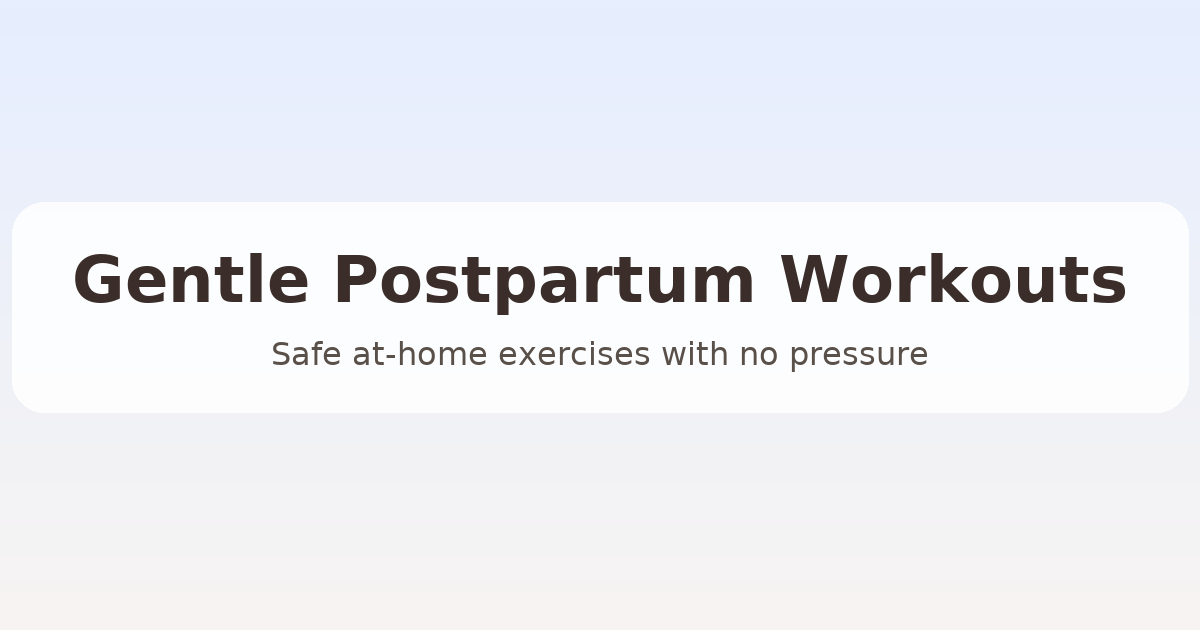
5 Best Gentle Postpartum Workouts You Can Do at Home
In the early postpartum months, your body is still healing — but that doesn’t mean you can’t move safely. In fact, gentle exercise can help:
- Improve mood and reduce stress
- Boost circulation and support healing
- Ease back and hip pain
- Restore core strength gradually
- Support pelvic floor recovery
The key is choosing movements that support your healing, not strain it. These five beginner-friendly exercises can be done at home with no equipment, and many moms can start them within the first few weeks postpartum (once cleared by a healthcare provider).
1. Diaphragmatic Breathing (Core + Pelvic Floor Reset)
Why it helps:
- Reconnects your core after pregnancy and birth
- Supports pelvic floor stability
- Improves posture and breathing patterns
- Can calm your nervous system and ease anxiety
How to do it:
- Sit upright or lie comfortably on your back with a neutral spine.
- Place one hand on your belly and one on your ribcage.
- Inhale slowly through your nose, allowing your ribs and belly to gently expand.
- Exhale slowly, imagining you’re hugging your baby toward your spine.
- Repeat for 10 slow, steady breaths.
When to start: Many moms can begin this within days after birth if their provider agrees.
2. Pelvic Tilts (Lower Back Relief + Core Activation)
Why it helps:
- Relieves lower back stiffness from feeding and holding baby
- Gently activates deep abdominal muscles
- Helps restore natural alignment in your spine and pelvis
How to do it:
- Lie on your back with your knees bent and feet flat on the floor.
- Take a breath in, then exhale as you gently tilt your pelvis so your lower back presses into the floor.
- Hold for 1–2 breaths, keeping your shoulders relaxed.
- Return to neutral and repeat 10–12 times.
Tip: Try to move from your core and pelvis, not by squeezing your glutes really hard.
3. Heel Slides (Safe Core Strengthening Without Crunches)
Why it helps:
- Strengthens the deep core without crunches or sit-ups
- Can be safer for diastasis recti than traditional ab exercises
- Builds control and stability
How to do it:
- Lie on your back with knees bent and feet flat.
- Gently engage your core — think “light hug,” not “squeeze as hard as possible.”
- Slowly slide one heel away from your body until your leg is almost straight.
- Slide the heel back to the starting position.
- Repeat 8–10 times on each side.
Avoid if: you see doming or bulging along the center of your abdomen. That’s a sign to pause and discuss with a professional.
4. Glute Bridges (Pelvic Stability + Back Strength)
Why it helps:
- Strengthens your glutes, which support your pelvis and lower back
- Improves hip stability
- Can help ease lower back pain over time
How to do it:
- Lie on your back with knees bent, feet hip-width apart.
- Engage your core slightly and squeeze your glutes.
- Press through your heels to lift your hips a few inches off the floor.
- Hold for 1–2 breaths at the top.
- Lower slowly and repeat 10–15 times.
Optional progression: Once you feel stronger and more stable, you can try lifting one leg at a time — but only after your provider says it’s safe.
5. Postpartum Walking (Low Impact, High Benefits)
Why it helps:
- Boosts circulation and supports healing
- Improves mood and reduces stress
- Gently supports cardiovascular health
- Helps you get outside and reset mentally
How to do it:
- Start with 5–10 minutes per day, even if it’s just around your home.
- Increase time gradually as your energy improves.
- Stroller walks, hallway laps, or quiet evening walks all count.
Important: If you notice heavier bleeding or a feeling of heaviness in your pelvis after walking, scale back and talk to your provider.
How Often Should You Do These Exercises?
Frequency: 3–4 days per week is plenty in the early months.
Duration: 10–20 minutes per session is enough to see benefits without overloading your body.
Tips for success:
- Move slowly and with intention — no rushing.
- Focus on breathing instead of “pushing through.”
- Stop if you feel pain, dizziness, or pressure.
- Remember that progress can be very gradual and that’s okay.
When to Talk to a Doctor or Specialist
It’s always okay — and smart — to slow down and ask for help. Pause exercise and reach out to your doctor, midwife, or a pelvic floor physical therapist if you experience:
- Sharp or worsening pelvic, back, or abdominal pain
- A sense of heaviness or “falling out” in your pelvic area
- Significant doming or bulging along the center of your belly
- Bleeding that becomes heavier with activity
- Dizziness, nausea, or shortness of breath
Final Thoughts: Gentle Movement Is Still Real Progress
Postpartum workouts aren’t about “earning your body back” — they’re about reconnecting with it. Each slow breath, tilt, slide, bridge, and walk is a small step toward feeling more stable, strong, and at home in your body again.
When you’re ready to learn more about the bigger picture of recovery — including timelines and nutrition — explore our main guide: Postpartum Body Recovery for First-Time Moms.